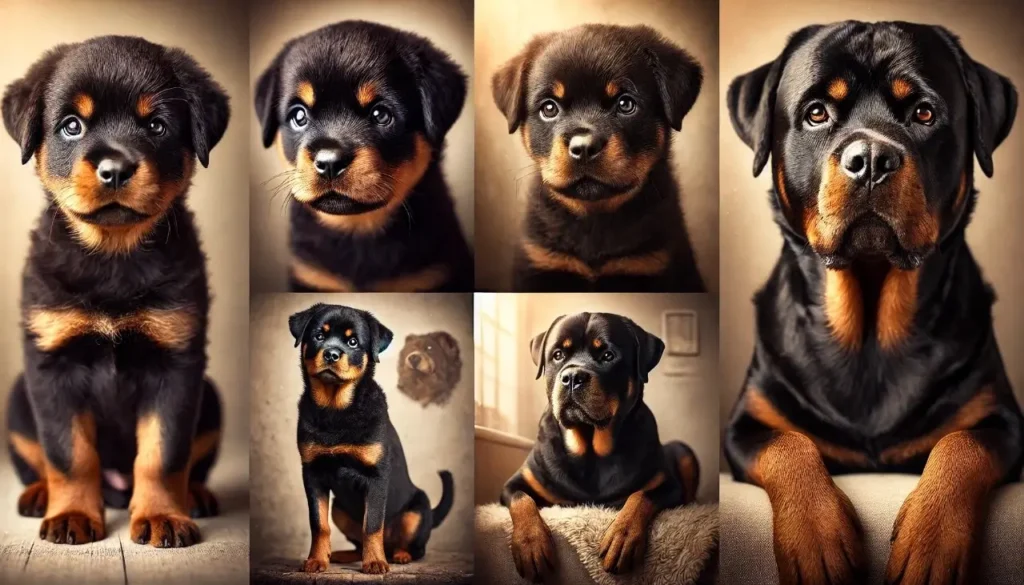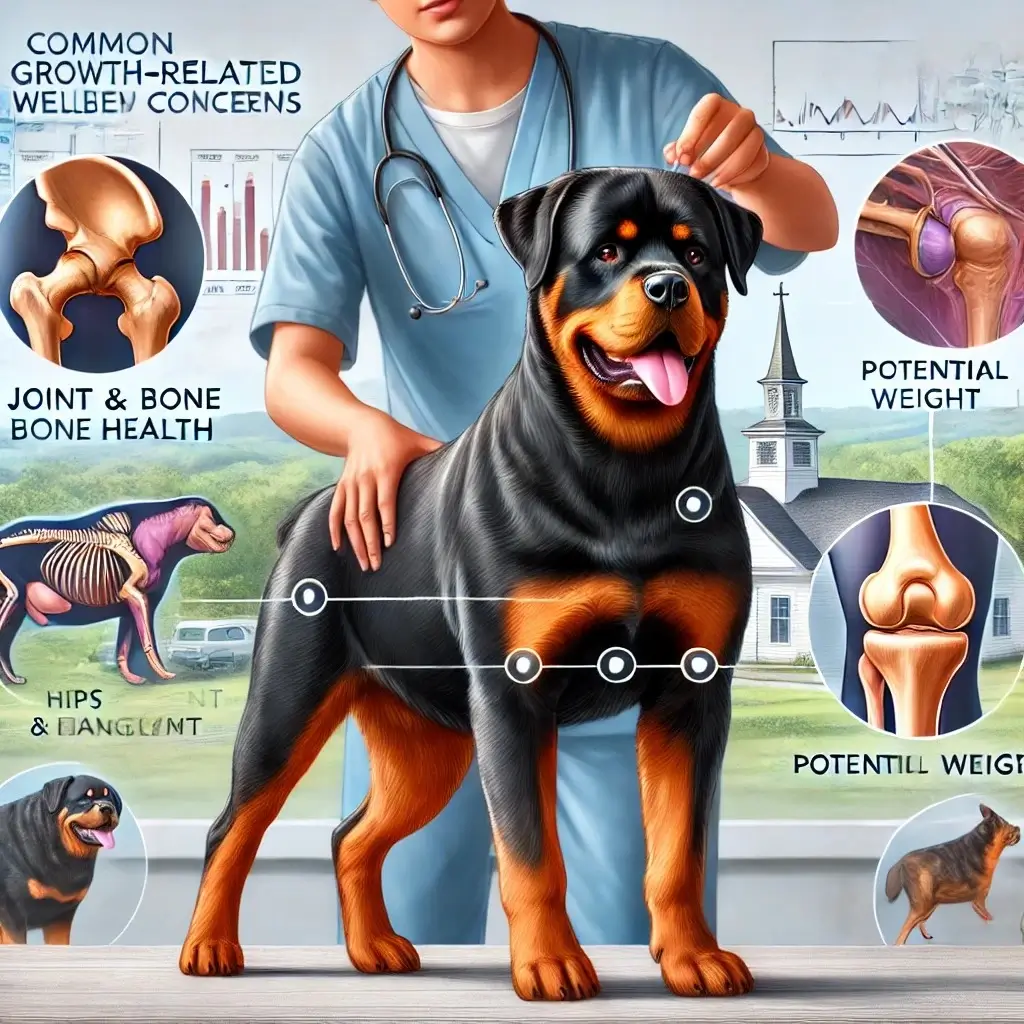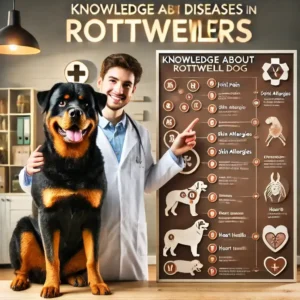When Do Rottweilers Stop Growing
When Do Rottweilers Stop Growing Timeline Rottweilers are known for their capable construction, insight, and devotion. If you’ve got a Rottweiler puppy, you will ponder how huge they will get and when they will halt development. Understanding stages can assist you in guaranteeing they create solid, well-proportioned grown-ups. This article will talk about when Rottweilers for the most part halt developing, key development stages, variables that impact their advancement, and tips to guarantee they develop ideally.
Understanding Rottweiler Development Stages

Rottweilers, like many large dog breeds, go through distinct growth stages, from rapid early development to a slower phase as they reach full maturity. Typically, a Rottweiler puppy’s growth period includes a rapid increase in size and weight in their first year, with most reaching their full height by around 18 months.
However, their final adult weight and muscle mass may continue to fill out until they’re 2-3 years old. By one year of age, Rottweilers generally reach about 70-80% of their adult size, with significant growth and development phases continuing into their second year.
Rottweilers rank as one of the more robust guard dog breeds and need a balanced diet to ensure healthy growth, especially for large-breed puppies prone to hip dysplasia. Monitoring a Rottie’s diet and providing supplements like glucosamine and chondroitin can support bone and joint health, while controlled activity levels prevent bone issues from rapid growth.
Proper training and socialization during this growth phase are crucial, ensuring they develop into confident, strong, and well-adjusted adults. Here’s a common timeline:
Infant to 8 Weeks:
During the first eight weeks, Rottweiler puppies experience rapid development and are exceedingly subordinate to their moms for sustenance and care. By the time they reach eight weeks, they are prepared to begin investigating strong nourishment.
3 to 6 Months (Puppy Development Spurt):
Between 3 and 6 months, Rottweiler puppies go through a critical development spurt. During this stage, they will quickly gain weight and height.
By 6 months, numerous Rottweilers have come to around 70% of their grown-up stature, but they still have a part of muscle advancement to go through.
6 to 12 Months (Youthful Organization):
Rottweilers regularly proceed to develop in height up to approximately 12 months, in spite of the fact that the pace starts to moderate compared to prior months.
1 to 2 A long time (Muscle and Bone Development):
By the conclusion of their to begin with year, numerous Rottweilers have accomplished their full height but proceed to pick up muscle and mass until they are around two a long time old.
Guys, in particular, tend to reach full solid and skeletal development between 18 to 24 months, whereas females may total this stage somewhat prior.
2 A long time and Past (Last Organize):
After 2 a long time, Rottweilers have as a rule accomplished their full physical development. They may proceed to pick up a few muscle mass quietly, but usually, they arrange where they are completely developed.
Components Affecting When do rottweilers stop growing
Hereditary qualities:
Hereditary qualities play the foremost noteworthy part in deciding the extreme measure of a Rottweiler. Bigger guardians are likely to deliver bigger descendants, even though there are no guarantees.
Sustenance:
Appropriate sustenance is pivotal for solid development. Rottweilers require a diet that is rich in protein, healthy fats, and other supplements basic for muscle advancement and bone development.
Overloading or bolstering low-quality nourishment can lead to weight gain, whereas underfeeding can result in hindered development or well-being issues.
Work out:
Working out underpins muscle development, keeps your dog’s joints sound, and makes a difference in keeping up a perfect weight. Be that as it may, over-the-top workouts, particularly in youthful Rottweilers, can put as much strain on their developing joints and bones.
Wellbeing Conditions:
A few well-being issues, like hip dysplasia, can influence the growth and physical advancement of Rottweilers. Regular veterinary check-ups are fundamental to screening their development and addressing any issues early on.
Spaying/Neutering:
Considers propose that early spaying or fixing can influence the development of plates in large-breed mutts like Rottweilers, possibly driving to expanded stature but conceivably weaker bones.
It is regularly prescribed to delay these methods until your Rottweiler is closer to 18 to 24 months.
How to Measure and Track Rottweiler Development
To get your Rottweiler’s development direction, measuring and following their height and weight month to month can provide valuable knowledge.
Measuring Stature:
Degree from the ground to the most elevated point of their shoulders (shrinks). Make sure beyond any doubt they are standing still on a level surface.
Weighing Your Puppy:
Weighing your Rottweiler monthly, especially in the first few years, helps track their growth and ensures they are maintaining a healthy weight. Since Rottweilers grow rapidly in their early months, reaching near adult height by 18 months, regular weight checks prevent issues associated with rapid growth, which can affect healthy bone development. Rottweiler puppies, like other large-breed puppies, need balanced nutrition to support their size and growth while avoiding excessive weight gain. Monitoring their diet and growth patterns with a vet ensures that your “Rottie” grows healthy and strong as they mature into a full-grown adult by around 2-3 years of age.
Employing a Development Chart:
A Rottweiler development chart can assist you gauge whether your dog’s development is on track. Rottweiler males regularly weigh between 95 and 135 pounds, whereas females are marginally lighter, averaging around 80 and 100 pounds when fully developed.
Signs That Your Rottweiler Is Completely Developed:
As growth rates shift, here are a few markers that your Rottweiler may have come to full measure:
- Relentless Weight: If your puppy’s weight has been steady for several months, it is a great sign that they are done developing.
- Muscle Definition: Grown-up Rottweilers have a strong, stocky appearance. After you take note of more muscle definition and totality, they’re likely at or close to their last measurement.
- Closed Development Plates: Your veterinarian can perform X-rays to confirm that your Rottweiler development plates have closed, showing they have come to full physical development.
Common Growth-Related Wellbeing Concerns

Hip Dysplasia:
Rottweilers are susceptible to hip dysplasia, a hereditary condition that can lead to joint pain and portability issues afterward in life. Keeping up a sound weight and checking workout levels can offer assistance in overseeing or anticipating indications.
Panosteitis (Developing Torment):
Some Rottweilers may encounter a brief bone inflammation known as panosteitis, which causes limping and inconvenience. This condition is ordinarily self-limiting and settles as the puppy develops.
Corpulence:
Managing a Rottweiler’s weight is essential, as rapid growth can lead to joint issues common in larger breeds. Rottweiler size and growth should be monitored with a weight chart, especially for growing puppies, as these working dogs can reach their full height by 18 months but often continue to fill out and gain muscle up to 3 years of age. Puppies should be fed a diet that supports steady growth and prevents excessive weight, which plays a significant role in long-term joint health and overall well-being. A vet can determine the best diet and care plan to maintain a healthy adult weight for your “Rottie.”
Rottweiler Growth and Maturity: A Guide to This Powerful, Loyal Breed
The Rottweiler, a powerful and loyal large breed, is known for its impressive physique and calm, protective nature. Male Rottweilers, in particular, often have a strong, muscular build and can weigh up to 135 pounds when they reach their full size. As a large breed, Rottweilers typically mature slower than smaller breeds, with physical growth continuing up to two years and mental maturity taking even longer. Once they reach their full potential, Rottweilers are known for their confident demeanor and make excellent family protectors and companions.
Conclusion:
Rottweilers are robust dogs with a solid build, and understanding their growth timeline helps manage their health, diet, and exercise needs effectively. Most Rottweilers reach their full height by 12 months of age, though they continue to fill out and gain muscle mass until about 2-3 years of age. Like other large breed puppies, Rottweilers require careful diet and nutrition to support their size and prevent rapid growth, which can lead to bone issues. Monitoring their growth and weight with a vet is essential to ensure your “Rottie” matures into a strong, healthy companion.proper care, your Rottweiler will develop into a solid, sound companion.
Frequently Asked Questions:
Most Rottweilers reach full height by 12 months and full weight and muscle development by 2 years.
Grown-up guys ordinarily weigh between 95 and 135 pounds and stand around 24 and 27 inches tall, whereas females weigh 80 and 100 pounds and stand 22 and 25 inches tall.
Yes, legitimate food is essential for solid development. A balanced diet with sufficient protein, fat, and other supplements underpins muscle and bone advancement.
Beware of hip dysplasia, weight, and panosteitis, which can all influence Rottweilers during their development stages.
Signs of development include a steady weight, full muscle advancement, and closed development plates, which a vet can confirm.











